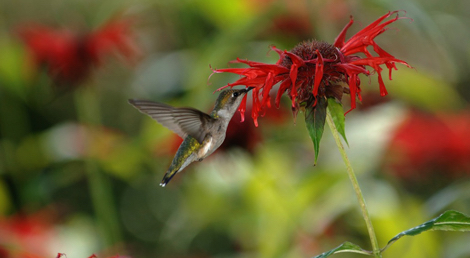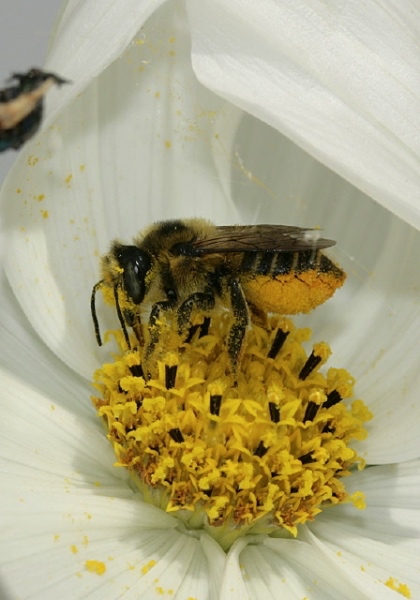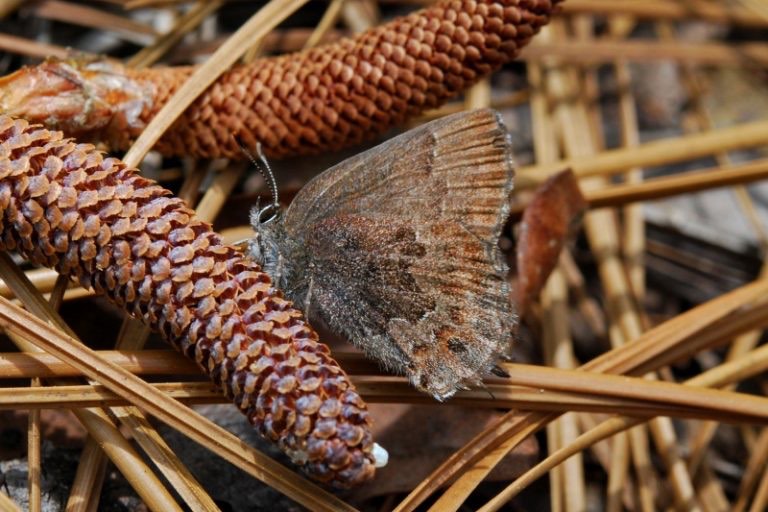
Pollinator Conservation
Apart from managed honey bees, there is increasing evidence that some wild bee species have experienced regional declines in North America. These include Bombus affinis, the Rusty Patched Bumble Bee, and Bombus terricola, the Yellowbanded Bumble Bee, most likely due to the introduction of diseases and parasites. Another bumble bee that is believed to have declined is Bombus pensylvanicus, the American Bumble Bee, for unknown reasons, although habitat changes are thought to be a contributing factor.
In addition, three species of Macropisoil bees appear to have drastically declined, possibly due to reductions in their host plants, native yellow loosestrife (genus Lysimachia). Unfortunately, the loss of these bee species will also result in the loss of parasitic bees that are dependent on them. For example, the cuckoo bee Epeoloides pilosula is an obligate parasite of Macropis oil bees, while Bombus ashtoni, the Ashton Cuckoo Bumble Bee, is an obligate parasite of Bombus affinis.
Although there is evidence for the decline of these and other species, it is not clear if there is a broad decline in all native bees. Despite a recent increase in studies of bees and other pollinators, the bottom line is that we still know very little about them.
Conservation Facts
- Pollinators support biodiversity—there is a correlation between plant diversity and pollinator diversity.
- Declines in bees and other pollinators may make plants more vulnerable to extinction.
- The protection of nectar corridors is important for migratory pollinators such as bats, hummingbirds, and the monarch butterfly. If nectar is unavailable anywhere along their migratory route at the time of migration, pollinators could perish.
- Nectar sources near areas where pesticides are sprayed may be tainted and harmful to pollinators. Herbicides may eliminate nectar sources.
Conservation Actions

Any basic conservation action, such as using natural resources sparingly, recycling, reducing energy consumption, supporting local agriculture—in general, living more sustainably, will also benefit native pollinators. However, you can take some specific steps that will benefit them directly.
- Protect habitat for nesting, feeding, resting, overwintering, and migration. This includes protecting the habitat for all life cycle stages—larvae, pupae, and adults.
- Maintain or restore habitat connectivity to ensure that pollinators have sufficient habitat to meet their needs. Connections between habitat patches also allow for dispersal to new areas.
- Plant native species when possible as native plants and insects have evolved closely together and are best adapted to the needs of many pollinators.
- Minimize use of herbicides and insecticides, and use the least-toxic chemicals when pesticides are necessary.
- Embrace unmanicured nature. Value “waste places” like farm hedgerows, old fields and field margins, and roadside embankments as they often provide nesting places for pollinators.
- Help your family, friends, and colleagues understand the importance of pollinators. Advocate for pollinator curricula in your children’s schools. This will go a long way toward countering “bee paranoia,” or “ insect paranoia” in general.
Major Threats to Pollinators
Bees and other insect pollinators are beset by the same environmental challenges as other species, including habitat loss, degradation, and fragmentation; non-native species and diseases; pollution, including pesticides; and climate change.
Habitat Loss, Degradation, and Fragmentation
Much pollinator habitat has been lost to agriculture, resource extraction, and urban and suburban development. Although these land uses can provide floral resources and benefit some pollinators, many bees and butterflies are habitat-specific, and the loss of habitat that provides sites for overwintering, foraging for pollen and nectar, or nesting can be detrimental to these species.
Habitat degradation, the decline in habitat quality, is another serious concern. For example, the loose, friable soil required by ground-nesting bees may be trampled by heavy foot traffic or the use of off-road vehicles. In cities, ground-nesting species may be particularly limited due to the large amount of landscape that has been covered with concrete or other impervious surface.
Many pollinators are adversely affected when large, intact tracts of habitat are broken up into smaller, isolated patches by road construction, development, or agriculture. These habitat fragments may not be large enough to meet all pollinator needs by themselves. Establishing and maintaining connectivity—safe passage among patches—is key to pollinator persistence in these areas.
Non-native Species and Diseases
Plants or animals brought here from other places can decrease the quality of pollinator habitat. When non-native shrubs such as autumn olive and multiflora rose take over open fields, they crowd out the wildflowers needed by certain butterfly and bee species for pollen, nectar, or larval food. For example, Japanese barberry shades out native spring ephemerals like Dutchman’s breeches, which provide food for early spring bumble bees. Some non-native plants also attract pollinators away from native species that are superior food sources. West Virginia white butterflies sometimes lay their eggs on non-native garlic mustard instead of native toothwort, for example, and the young caterpillars fail to thrive. In other instances, non-native species can compete with native plants or animals for resources—in fact, in some habitats European honey bees have been shown to compete with native bees for pollen and nectar.
Introduced parasites and diseases are still another threat to pollinators. Thus far, the effects of these parasites have been species-specific, including the mite and virus species that have severely compromised honey bee colonies.
Thus far, approximately 40 species of non-native bees have been documented in North America, including the European Honey Bee. It is unclear if many of them are having a negative effect on native bees. Surveys indicate that populations of these non-native bees currently are not very large in most locations (although there are some exceptions), suggesting that right now they may not be having a major impact on native bees. However, given the history of introductions that subsequently cause major ecological damage, it is important to carefully monitor populations of introduced bee species.
Although they were intended to be beneficial at the time, some non-native organisms introduced as biocontrol agents have caused problems for native species. For example, non-native lady beetles introduced to this country for aphid control have eliminated New York’s state insect, the nine-spotted lady beetle. These introduced lady beetles have even been found to feed on Monarch butterfly caterpillars. Since the 1950s, the tachinid fly Compsilura concinnata, introduced in the early 1900s to control gypsy moths, has likely contributed to the regional decline of the large sphinx moths that pollinate flowers such evening primrose and certain orchids.
It’s important to note that overabundant native species can also be a problem for plants and animals in the metropolitan region. White-tailed deer numbers have increased over the years, due in part to the fragmentation of forest habitat into the open areas they prefer. Deer browse removes understory vegetation that caterpillar larvae and other pollinators depend upon. For example, deer often preferentially feed on native shrubs such as spicebush, the host plant of the spicebush swallowtail caterpillar, while avoiding thorny non-native bushes like Japanese barberry.
Pollution, Including Pesticides
Air pollution is a very real problem for bees and other pollinators that rely on scent trails to find flowers. Light pollution can harm moth pollinators by increasing their susceptibility to predation by bats or birds when they are attracted to artificial lights at night.
Pesticide misuse and drift from aerial spraying are a major threat to insect pollinators, especially spraying with so-called persistent chemicals that remain in the environment for a long time before degrading. Systemic insecticides applied to seeds can contaminate the pollen grains that are an essential source of food for bees and their young. Pesticides often kill directly, but sub-lethal amounts can also be detrimental to bees and other pollinators by impeding their ability to navigate or forage. The use of herbicides that eradicate important forage plants for bees and other pollinators is an additional problem.
Climate Change
Studies predict that climate change will alter the close relationship between insect pollinators and the plants that depend upon them for reproduction. Flowering plants migrating north or to cooler, higher elevation habitat in response to warming temperatures or other changes may not move in sync with their pollinators. The composition of pollinator communities is expected to change. According to the Xerces Society, anecdotal observations have found that bumble bees adapted to cooler temperatures are in decline, while bumble bees adapted to warmer temperatures are expanding their ranges northward. What effect this will have on local plants is unknown.
Declining Bumble Bees
Survey and Monitoring
One of the ways scientists learn which species and habitats require conservation measures is by conducting biological surveys or inventories and regularly monitoring populations of plant or animal species over time to detect trends in their numbers. For example, breeding bird surveys conducted in the U.S. each year since the 1960s have identified which bird species are doing well and which are in decline, leading to more focused conservation measures. In addition to national surveys, each state also conducts its own surveys of plant and animal species.
Types of Studies
Several different types of studies are used to assess the health of species and habitats, including:
- Survey or inventory: a point-in-time measurement of the resource to determine location or condition
- Census: a periodic count of the entire population
- Sample: measurement of a small subset of the population, as a representative of the larger population
- Atlas: a comprehensive survey of a large geographical area that maps the occurrence (or occurrence and relative abundance) of species in subdivisions of that area. An atlas is usually based on a grid of fixed intervals of distance or degrees latitude and longitude. It is restricted to a particular season of the year, usually the breeding season.
- Monitoring: the collection and analysis of repeated observations or measurements to evaluate changes in condition. For example, monitoring species typically involves studying their numbers, abundance, distribution, reproduction success, etc. Natural communities are often monitored for plant species composition and associated fauna, habitat quality, threats, etc.
Who Does Surveys and Monitoring?
A number of government agencies and organizations are engaged in survey and monitoring. Federal agencies include the U.S. Fish and Wildlife Service and the U.S. Geological Survey.
Some conservation organizations also do surveys and monitoring. For example, the International Union for Conservation of Nature (IUCN) compiles the Red List of globally imperiled species. The annual migration of the Monarch butterfly is included as an “endangered biological phenomenon,” but no pollinator species from the region are listed. The Xerces Society publishes Red Lists of imperiled or vulnerable pollinators and butterflies and moths specifically.Other groups that do survey and monitoring include the Natural Heritage Program in each state, academia, and citizen scientists. Natural history museum collections are important repositories of species information. Currently, American Natural History Museum scientists are databasing the AMNH bee collection, entering information from each specimen label (location, date of collection, species identification) online at discoverlife.org.
Although extensive work has been done on vertebrate species, many plant species, and some invertebrates such as dragonflies and freshwater mussels and snails, we know very little about most insect pollinators. Butterflies may be the best known pollinators in part because there are not too many species and good regional identification guides exist. For example, a new resource, Butterflies and Moths of North America is a user-friendly database that contains the most comprehensive online distribution record of butterfly and moth species available for our region. More than 247,000 records and nearly 4,300 species accounts are accessible via the website through dynamic distribution maps, checklists, and species accounts. Fourth of July butterfly counts are one-day surveys of all butterfly species observed within a defined area. As their name suggests, these are typically held sometime during the 2-week period around July 4 th. They provide a snapshot in time of species and numbers and can show general trends over time for local butterflies.
Native bees are especially difficult to identify, requiring collection and specimen preparation, and they can also be challenging to survey. Nevertheless, more studies are being conducted and iNaturalist and other citizen science apps are contributing greatly to our knowledge of native bees.
Guidelines for Survey and Monitoring
To improve our ability to better detect and understand population trends and develop conservation programs, various guidelines have been developed for insect surveys and monitoring.
General:
New, T R. 1998. Invertebrate Surveys for Conservation. Oxford University Press.
Bees:
Droege, S. 2012. The Very Handy Manual: How to Catch and Identify Bees and Manage a Collection This document contains everything you need to know to collect, survey and monitor bees.
The Bee Monitoring Listserve disseminates information and fosters discussions on the inventory and monitoring of bees as well as their identification.
Butterflies and Moths:
Pollard, Ernest and Tina J. Yates. 1993. Monitoring Butterflies for Ecology and Conservation . Chapman and Hall, Inc. New York, NY. 274 p.
Rzeszotarski, MS and JL Wiedmann. 2008. Long-term Butterfly Monitoring Project – Instructions for Recorders. Publication of The Ohio Lepidopterists.
How Imperiled Are They?
Following are terms used to describe a species’ conservation status:
- Endangered: any species in danger of extinction in the foreseeable future throughout all or a significant portion of its range
- Threatened: Likely to become in the near future if limiting factors are not reversed
- Extinct: no longer in existence on Earth
- Extirpated: locally extinct
- Special concern/rare: may or may not be threatened or endangered but may be extremely uncommon (e.g., exists in only one or two restricted geographic areas or habitats, or occurs in low numbers over a relatively broad area) or have unique or highly specific habitat requirements and therefore deserves careful monitoring.
These terms are used to describe conservation status at various levels, including global, national, state, or local.
Legal Protection

Despite the importance of pollinators, there are few local, state, and federal laws protecting them. Depending on the jurisdictional oversight, protections afforded by listing as endangered or threatened or other category typically include protection from harassment or collection. Occasionally critical habitat is protected as well. The few protections that are in place include:
International
CITES (Convention on International Trade in Endangered Species) is an international treaty whose signatory countries, including the U.S., work together to prevent international trade of vulnerable wildlife species.
Federal
The Endangered Species Act authorizes the U.S. Fish and Wildlife Service to list endangered and threatened species, triggering protection measures.
Connecticut recently listed the Macropis Cuckoo Bee ( Epeoloides pilosula) as endangered and the Fringed Loosestrife Oil Bee ( Macropis ciliata) as a species of special concern. Three bumble bees are also listed as species of special concern, without formal protection — the Affable Bumble Bee ( Bombus affinis), Ashton’s Bumble Bee ( Bombus ashtoni), and Yellowbanded Bumble Bee ( Bombus terricola). Several butterfly and moth species are listed as threatened and/or endangered species in the state, affording them legal protection from harassment. Examples include the Northern Metalmark ( Calephelis borealis), endangered; Hessel’s Hairstreak ( Mitoura hesseli), endangered; and Frosted Elfin ( Callophrys irus), threatened .
New York State has no protection for native bee species but does afford protection for a number of butterfly and moth species, including the Regal Fritillary ( Speyeria idalia), Arogos Skipper ( Atrytone arogos), Hessel’s Hairstreak ( Mitoura hesseli), and Frosted Elfin ( Callophrys irus) .
New Jersey has no protection for native bee species but does afford legal protection for a number of rare moth and butterfly species, such as the Arogos Skipper ( Atrytone arogos) and Frosted Elfin ( Callophrys irus) .
Regional
Some protected areas have special regulations for pollinators in place, such as the Albany Pine Bush in New York State, which protects critical habitat for the federally protected Karner Blue butterfly ( Lycaeides melissa samuelis).
